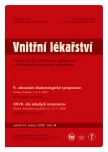System rennin-aldosterone in fat tissue and other organ and tissues
Authors:
Š. Svačina
Authors‘ workplace:
III. interní klinika 1. lékařské fakulty UK a VFN Praha, přednosta prof. MUDr. Štěpán Svačina, DrSc., MBA
Published in:
Vnitř Lék 2008; 54(5): 508-510
Category:
Overview
Important mechanism of pathogenesis of hypertension in obesity is renin-aldosterone system in adipose tissue. Adrenal cells can be also stimulated to aldosterone secretion by local adrenal fat cells and also by other factors from fat tissue (lipids, endocrine disruptors). Local system renin-aldosteron is active also in other tissues and organs in obesity related hypertension. Feed back is closed by recently investigated fact that aldosteron hypersecretion can cause metabolic syndrome. Between systemic approach to obesity a new phenomenon of organ obesity is coming - adipokines from local fat cells can influence organ and tissue function e.g. in essential hypertension.
Key words:
hypertension - obesity - metabolic syndrom - mineralocorticoids - endocrine disruptors
Sources
1. Carey RM (ed). Hypertension and hormon mechanism. Totowa: Humana Press 2007.
2. Della Mea P, Lupia M, Bandolin V et al. Adiponectin, insulin resistance, and left ventricular structure in dipper and non- -dipper essential hypertensive patients. Am J Hypertens 2005; 18: 30–35.
3. Ehrhart–Bornstein M, Lamounier- -Zepter V, Schraven A et al. Human adipocytes secrete mineralocorticoid-releasing factors. Proc Natl Acad Sci USA 2003; 100: 14211–14216.
4. Fallo F, Veglio F, Bertello C et al. Prevalence and characteristics of the metabolic syndrome in primary aldosteronism. J Clin Endocrinol Metab 2006; 91: 454–459.
5. Fantuzzi C, Mazzone T. Adipose Tissue and Adipokines in Health and Disease. Totowa: Humana Press 2007.
6. Garrison RJ, Kannel WB, Stokes J 3rd, Castelli WP. Incidence and precursors of hypertension in young adults: the Framingham Offspring Study. Prev Med 1987; 16: 235–251.
7. Goodfriend TL, Egan BM, Kelley DE. Aldosterone in obesity. Endocr Res 1998; 24: 789–796.
8. Hinson JP, Raven PW. Effects of endocrine-disrupting chemicals on adrenal function. Best Pract Res Clin Endocrinol Metab 2006; 20: 111–120.
9. Lamounier-Zepter V, Rotthoff T, Ansurudeen I et al. Increased aldosterone/renin quotient in obese hypertensive women: a novel role for low-density lipoproteins? Horm Metab Res 2006; 38: 471–475.
10. Lamounier-Zepter V, Ehrhart-Bornstein M. Fat tissue metabolism and adrenal steroid secretion. Curr Hypertens Rep 2006; 8: 30–34.
11. Lamounier–Zepter V, Ehrhart-Bornstein M, Bornstein SR. Mineralocorticoid- stimulating activity of adipose tissue. Best Pract Res Clin Endocrinol Metab 2005; 19: 567–575.
12. Lazartigues E, Feng Y, Lavoie JL. The two fACEs of the tissue renin-angiotensin systems: implication in cardiovascular diseases. Curr Pharm Des 2007; 13: 1231–1245.
13. Sharma AM, Grassi G. Obesity and hypertension: cause or consequence? J Hypertens 2001; 19: 2125–2126.
14. Svačina Š. Hypertenze při obezitě a diabetu. Praha: Triton 2007.
15. Svačina Š. Víme, proč vzniká hypertenze u obezity? In: Widimský J (ed). Arteriální hypertenze – současné trendy. V. symposium. Praha: Triton 2007: 35–41.
16. Svačina Š. Hyperaldosteronizmus, obezita a metabolický syndrom. In: Widimský J (ed). Arteriální hypertenze – současné trendy. V. symposium. Praha: Triton 2007.
17. Thakur V, Richards R, Reisin E. Obesity, hypertension, and the heart. Am J Med Sci 2001; 321: 242–248.
18. Vela D, Buja LM, Madjid M et al. The role of periadventitial fat in atherosclerosis. Arch Pathol Lab Med 2007; 131: 481–487.
19. Verlohren S, Dubrovska G, Tsang SY et al. Visceral periadventitial adipose tissue regulates arterial tone of mesenteric arteries. Hypertension 2004; 44: 271–276.
Labels
Diabetology Endocrinology Internal medicineArticle was published in
Internal Medicine

2008 Issue 5
Most read in this issue
- Metformin and kidneys
- Haemocoagulation and renal insufficiency, haemocoagulation and type 2 diabetes mellitus
- Specific issues of dialysed diabetics in outpatient practice
- Examination of the kidneys in a diabetic patient
